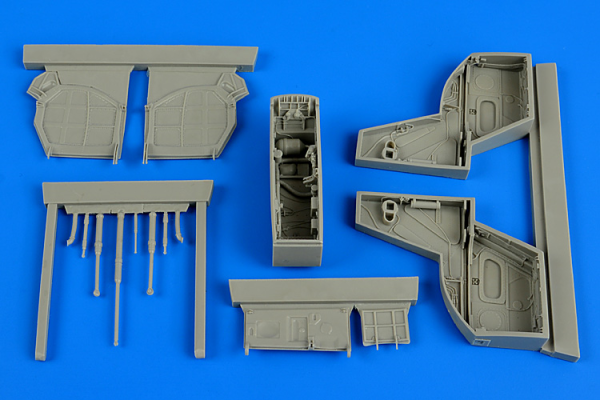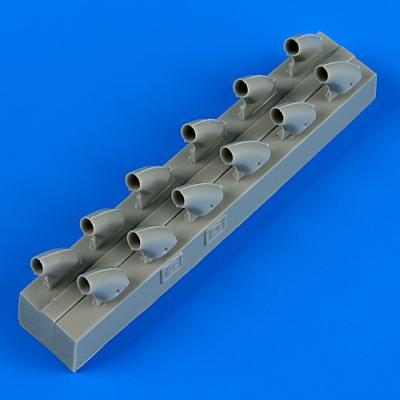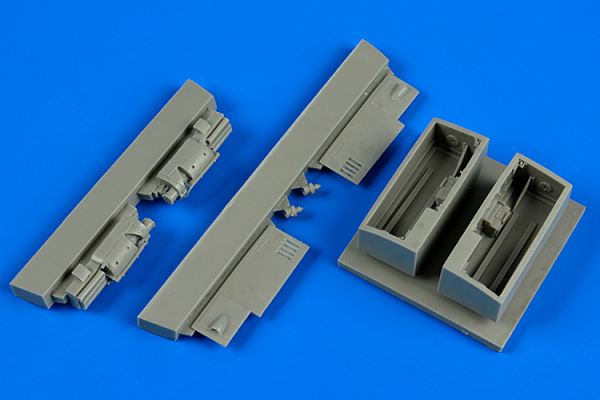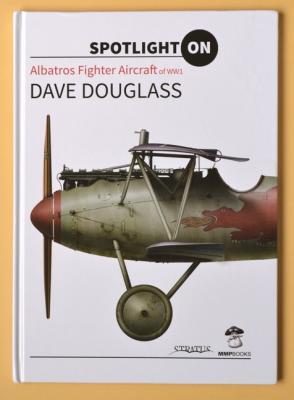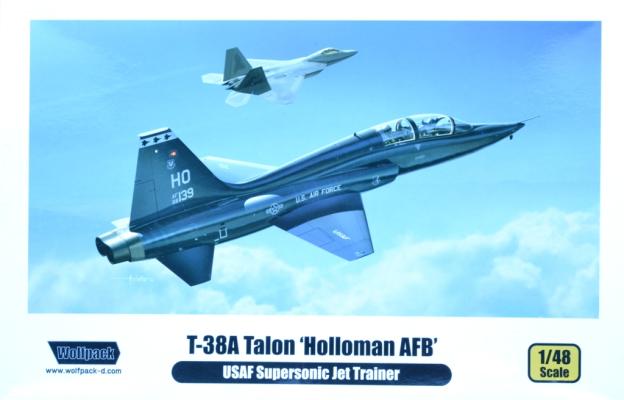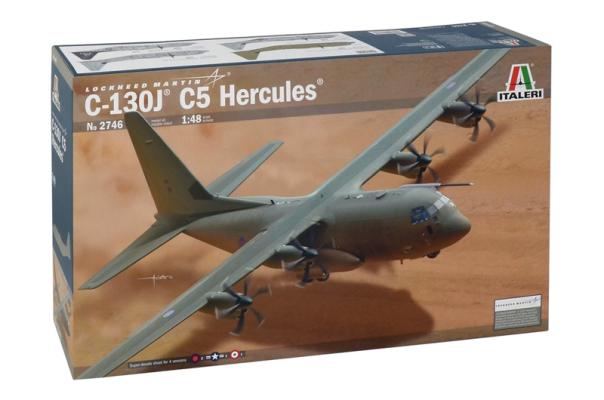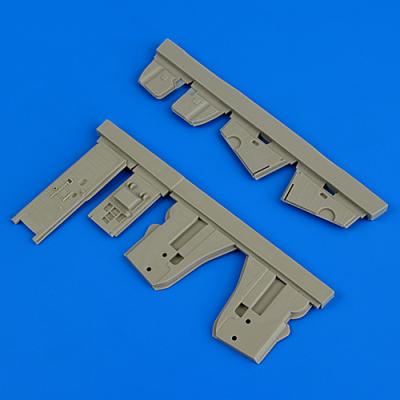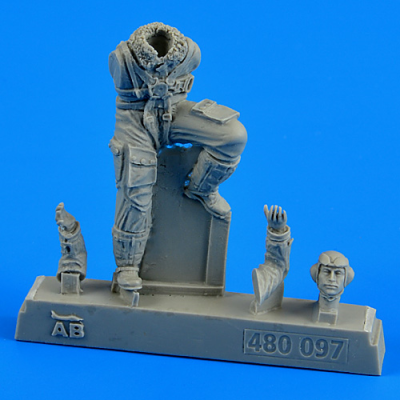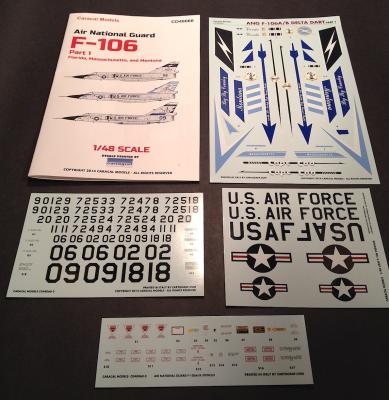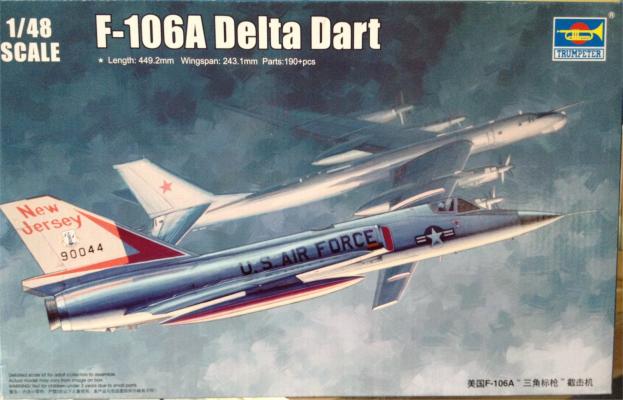Many of us have waited a long time for a quality kit of the Kfir, and Kinetic released a very fine example about a year ago. Though the kit is very detailed, of course there is always room for improvement and embellishment, so Aires has come up with a couple of offerings for this kit. One of these is a very nice set of highly detailed main and nose gear wheel wells. All together there are fifteen exquisitely detailed parts that include new doors and actuators for each of the wells. Both the main gear well and nose gear well include all of the plumbing that is inherent in those wells.
Quickboost has added a highly detailed set of P-40E Warhawk exhaust pipes to their aftermarket parts line that can be used to replace the two-part ones found in Hasegawa’s 1:32 scale kits (Note that the pipes are correct for the early P-40Es [and Ds] that had the circular shaped pipes). The twelve one-piece Quickboost pipes provided in this set allow model builders to avoid the repetitious assembly of the kit’s 24 parts, thereby making the whole process of installing exhaust pipes a bit easier and faster (see the comparison photo below of the Quickboost parts and the kit parts that had been pre-painted on the sprues). In addition to the convenience they offer, the Quickboost pipes will add a little higher level of detail. They capture the look of the prototype very nicely with crisp (and more refined) details that include the raised weld beads that easily can be lost when assembling and cleaning up the kit parts.
Many of us have waited a long time for a quality kit of the Kfir, and Kinetic released a very fine example about a year ago. Though the kit is very detailed, of course there is always room for improvement and embellishment, so Aires has come up with a couple of offerings for this kit. One of these gives the modeler the capability of opening the gun bays and showing the two Rafael DEFA 553 30mm cannons.
Packed in the normal Aires card and bubble pack one will find three pour blocks which include two gun bays, two gun breeches and two gun bay doors with latches. The detail is typical high quality Aires. The installation is rather simple. All the modeler has to do is remove the two doors from the lower wing half and install the bays and the doors. There is no great concern about having to thin everything as much as possible on this installation.
For the modeler who likes to display all of the various bays open, this is a great addition to the Kinetic Kfir.
The first book in Mushroom Model Publications new “Spotlight On” series presents an array of beautiful color profiles of Germany’s famous WWI Albatros fighter family…from the D.I through the D.Va.For the most part, the 41 pages that form the bulk of the book display what may best be described as a one-man gallery of very detailed illustrations depicting very realistically the variety of camouflages and personal markings that adorned many of these elegant aircraft.
Background
The world’s first and most-produced supersonic trainer, the Northrop T-38A Talon has trained over 5,000 military pilots since its introduction to service in 1961. Of the nearly 1,200 T-38A’s produced, the US Air Force continues to operate over 500 of the type as of 2014, of which most will be upgraded to T-38C configuration with new wings and improved avionics, including heads-up display and inertial navigation systems, and will continue to operate them until at least 2020.
The Academy family of F-4 Phantoms are impressive kits. I absolutely love them. They are very detailed, but as always there is room for improvement. Enter Quickboost.
Packaged in typical Quickboost bottom opening package with a cardboard stiffener. Two pour stubs of light grey resin hold eight resin pieces that are blemish free. They contain beautiful detail on both sides. They are easy enough to remove from the pour blocks and are direct replacements for the kit parts.
This latest offering from Aerobonus is typical of their line of figures. There is one pour stub containing four pieces of flawless light grey resin. There are two arms, body and head. That sounds all kind of boring but this figure is molded as if he were exiting a late war Bf-109. The two separate arms are set to lay on the top of the canopy frame. The arms are added on a natural seem line. The legs are already set to have one leg on the seat and the other on the canopy sill, no assembly required on them. Overall clean up is relatively easy. The pour stubs are small and easy to remove.
The F-106 served active duty Air Force squadrons from 1959 to 1981. As the aircraft were replaced with the new F-15A, those Darts were relegated to six Air National Guard, Fighter Interceptor Squadrons (FIS). Those squadrons used the F-106 until their final retirement in 1988. Three of those units are the subjects of this release from Caracal Models. The zip lock bag contains four sheets of decals that include every marking needed to finish your F-106 with the exception of the weapon stencils and instrument panels. For that you’ll need to use the kit decals.
You get decals for a single seat and a two-seat version from each of the following units.
Introduction
The F-106 was a direct development of the F-102 first conceived of in 1951. This supersonic all weather interceptor had a number of advanced features for its time including fully enclosed weapons bay and a delta wing platform. The F-106 further developed the concept with a more powerful Pratt and Whiney J75 engine and the unique area rule or coke bottle fuselage that enabled the F-106 to reach twice the speed of sound. The F-106 was equipped with the first guided missiles used by the USAF. The Aim 4E was semi radar guided and the Aim 4G was a heat seeker. The aircraft could also carry nuclear weapons. The F-106 never saw combat but did intercept countless Soviet bombers over the course of its career. They served over 20 years with the USAF and 16 years with various ANG units. Notable is the fact that the F-106 finished its run with the lowest single engine aircraft accident rate of any USAF aircraft.

